
The Remington Model 770, like the Model 710, is a an application specific firearm. It isn’t meant to appeal to our appreciation for tradition. It may be an engineering exercise that answers the question, “If I didn’t have to be concerned with tradition, what would be the optimal bolt action hunting rifle?”. Don’t get me wrong, the Model 770 is a good looking firearm. Perhaps not in the sense of hundred year old gun art, but more in the sense of a good set of hand tools, or a new lathe or a high lift camshaft. The Model 770 is a no frills, purposeful firearm that puts modern materials and manufacturing technology on display.
Overview
|
Remington Model 770 Bolt Action Rifle |
|
| Manufacturer | Remington Arms Company, Inc. |
| Model | 85631 |
| Type | Bolt Action |
| Caliber | 7mm-08 Remington |
| Mag Capacity | 4 |
| Barrel Length | 22″ |
| Rifling | 1:9.25″ 6 Groove RH |
| Weight | *6 lbs 14 oz. |
| Overall Length | 42.5“ |
| Stock | All Weather Synthetic |
| Hardware | Matte Carbon Steel |
| Length of Pull | *13.0″ |
| Drop at comb | *0.75″ |
| Drop at heel | *1.0″ |
| Metallic Sights | None |
| Scope | 3-9x40mm Installed |
| Trigger Pull | *6 lbs. 5 oz. Non-Adj |
| Safety | 2 Position Thumb Safety |
| MSRP | $373 With Scope |
|
* Actual weights and measures. |
|
Announced in October 2006, the Remington Model 770 is the follow on release to the Model 710, a gun produced between 2001 and 2006. The Model 770 is available in: .270 Win, .30-06 Sprgfld, 7mm Rem Mag, .300 Win Mag, .243 Win, 7mm-08 Rem and .308 Win. Both models were/are produced in Remington’s Mayfield, KT facilities. There are plain, camo and compact versions of the Model 770 are available.
That whole, Model 700, Model 710 Model 770 thing…
It’s only natural to draw comparisons between the newcomer Model 770 and the iconic Remington Model 700, with the basic understanding that differences are not inherently good or bad and that both models have very different price points.

Like the German made $3,000+ Heym SR 30, the Remington Model 770 has a closed top receiver and an oblong ejection port rather than the Model 700’s open top receiver. While it is easy to single feed a round through the ejection port of the Model 770, its center feed magazine cannot be topped off in this manner, but then it is a detachable magazine rifle design. The Model 770’s ejection port, at 3.800″, is actually longer than the Model 700’s 3.25″ port and the bolt face ejector is opposite the port; cases eject to the side, not up so the closed receiver is of no consequence.
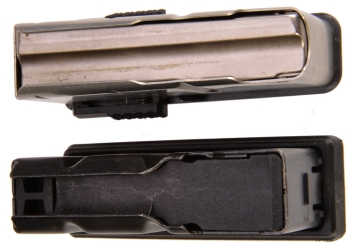
The top left magazine is from an early stagger feed Model 700 DM mountain rifle, the lower center feed magazine is from the Model 770. While the center fed precludes top loading through the ejection port, it provides improved feed reliability
The Model 770, like its predecessor, the Model 710, comes in one action length to accommodate 3.340″ cartridges; 30-06 Sprgfld, similar length belted magnums. Magazines for 2.800″ rounds, like the .243 Win or 308 Win, get a spacer at the aft end for proper round positioning. The bolt stroke is the same for all chambers.
The Model 700 long action, capable of handling Ultra Mag and full length H&H magnum cartridges has a bolt stroke of 4¾” compared to the Model 770’s 4⅝” stroke. From a feed port standpoint, while the Model 770 has room to comfortably feed .30-06 Sprgfld length cartridges both standard and belted magnum, there is insufficient room for full length magnums like the 375 H&H and Ultra Mag series. Additionally, barrels are not threaded and cannot be changed on the Model 770 as they can on the Model 700, below, top.

The Model 770 barrel is pressed and bonded into the receiver rather than screwed into the receiver with a conventional threaded barrel shank. Because the bolt head locks up in lug seats that are integral to the barrel shank rather than to the receiver, the Model 770 action is a full half inch shorter than the Model 700. Unless there is a future plan for a custom rebarrel, not being able to change a barrel is of no consequence. What about when the barrel get’s shot out at 7,000 to 10,000 rounds? The MSRP for rifle and scope is $373, which I believe answers that question.
Comparisons of the Models 770 and 700, in regard to method of barrel attachment to the receiver and resulting strength, is misleading unless the underlying designs are examined. The Remington Model 700 action bolt lugs are supported against lug seats that are integral to the receiver. On discharge, several thousand pounds of bolt thrust are applied to the bolt face and action, and an opposite and equal force is applied to the face of the barrel shank. Within this design, the barrel must be threaded to resist this force and to retain the barrel in the receiver.
The Model 770 action does not have receiver based lug seats, the lug seats reside within the barrel shank so forward/rearward thrust is contained within the barrel in a state of equilibrium, making the security of a barrel threaded to the receiver not necessary. Sound strange? Think AR 15 as, not unlike an AR 15, the Model 770 receiver mostly hangs onto the end of the gun’s barrel, serving only to guide the bolt when cycled and facilitates feed, extraction and ejection.
Wonder whatever happen to Michael Bolton? I always hated that guy…
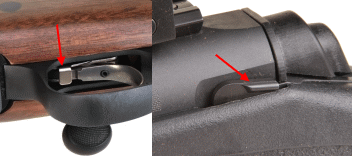 While the Model 700 bolt stop is released by depressing a small spring loaded tab just forward and above the gun’s trigger, the Model 770 has a bolt stop at the top left side of the action that is released by rotating it upward and forward. The part fits in well with the Model 770’s quest for piece part reduction without compromising functional quality.
While the Model 700 bolt stop is released by depressing a small spring loaded tab just forward and above the gun’s trigger, the Model 770 has a bolt stop at the top left side of the action that is released by rotating it upward and forward. The part fits in well with the Model 770’s quest for piece part reduction without compromising functional quality.
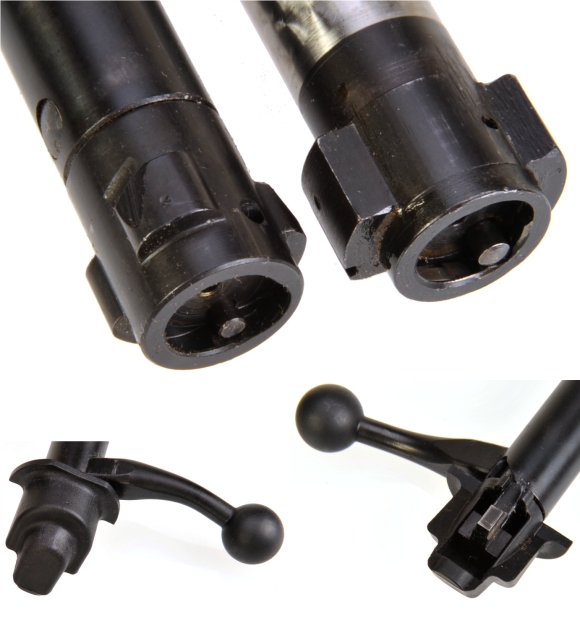
 The Model 770 bolt handle is a welded on affair. The bolt handle on a Model 700 that wraps around the bolt body is silver soldered in place… and these parts are not having an affair. Neither will come loose. The Model 700 bolt shroud is a sleek nicely finished part, the plastic cap on the Model 770, which carries the nomenclature “bolt plug”, not so much. It serves it’s purpose 100%, but it appears to be doing so under protest.
The Model 770 bolt handle is a welded on affair. The bolt handle on a Model 700 that wraps around the bolt body is silver soldered in place… and these parts are not having an affair. Neither will come loose. The Model 700 bolt shroud is a sleek nicely finished part, the plastic cap on the Model 770, which carries the nomenclature “bolt plug”, not so much. It serves it’s purpose 100%, but it appears to be doing so under protest.
Of much greater consequence, the Model 770 is a three lug design for a 60° lift where the Model 700 has a 90° lift. Total lug contact area is about the same. I don’t know if 30°s less rotation is a speed benefit, but it does keep the bolt handle down to clear large scope eyepieces that are so prevalent these days, even with lower mounts. Both models are push feed rather than control feed. They both use the same design extractor and ejector which are solid designs in both cases. The Model 700 bolt face above, the jeweled bolt, is larger to accommodate an Ultra Mag cartridge. The subject Model 770 is chambered for the 7mm-08 Remington.
The Model 770 design, as is the case with the Model 700, features the three rings of steel feature. The cartridge case head is enclosed in the bolt, inside the chamber and inside the receiver ring. Sort of like Dante’s nice circles, only there are three… and no devil… I have no idea where I was going with this one. In perspective, and more to the point, this model has the same high level of case and pressure containment found in Remington’s premium priced rifles.
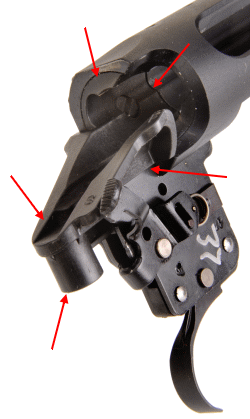
Where the Model 700 has a fixed bolt head, the Model 770 has a floating head which enhances lug lock up alignment. Initially, this example’s bolt travel was sticky. Cleaning and lube didn’t seem to have much of an effect, however, just working the bolt during handling and shooting seemed to take care of the problem in short order. Sometimes metal has to rub against metal before pieces conform to one another. In any event, this was not a persistent problem with the rifle.
The Model 770’s predecessor, the Model 710 had a full length polymer insert within the steel receiver that was to act as a bolt guide. With cause, or not, this feature became the critical mantra that dogged the Model 710 throughout its production life. The Model 770 discards the full length insert, but retains a truncated version of the insert that runs from the rear receiver ring back to form the receiver’s tang and aft fastening point. Fiber filled poly, I am sure it is up to the task, including being the aft pin mount point for the gun’s trigger.
The Model 770 trigger is non-adjustable and it not one of the X Mark Pro generation triggers. It isn’t bad, but pull is a bit heavy at a measured six pounds, five ounces. The pull is crisp and there is minimal overtravel.
Shockin’ Stockin’
The Remington Model 770 has an injection molded poly stock, not to be confused with a composite material molded stock. It’s scalloped and contoured surfaces are actually external ribbing that makes for a very rigid stock that can still absorb and dissipate recoil.
The surfaces are non-slip and attractive in an industrial, purposeful way. The detachable mag is recessed flush with the stock and the release catch, while very positive in engagement, is also easy to release when desired. Sling swivel attach points are integral to the stock as is common practice these days with most manufacturers. No, I do not know why the dropped flat behind the trigger guard other than triangulated reinforcement of the guard.

The stock is secured in three places, two 1⁄4″-28 x mount screws in the front on either side of the recoil lug insert, a single smaller fastener aft of the trigger guard. Where the Model 700 has a recoil lug sandwiched between the barrel and the receiver, the Model 770 has a slot cut in the underside of the barrel that engages the recoil lug in the stock. There is lots of internal ribbing for strength and thing horizontal pressure pads to support the barreled action while minimizing contact pressure points for optimal accuracy.
Ready to roll…
The Remington Model 770 ships with a 9-9x40mm scope installed and bore sighted. I’ve seen comment made that a person bought a Model 770 and it was not on bullseye when taken from the box. For people who shoot rifles, most understand that bore sighting is only an approximation based on mechanical and optical alignment of bore and scope. In real life, eyesight and other mechanical elements determine point of impact. Additionally, in most cases, different bullet weights hit to a different point of impact as a matter of barrel harmonics and external ballistics.
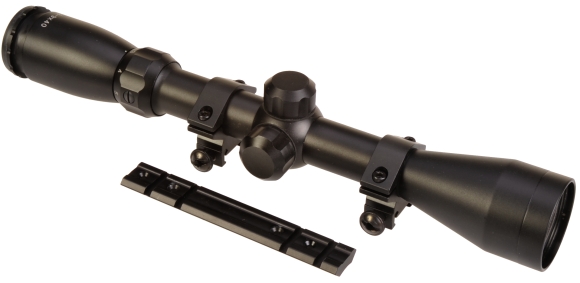
I can go on the assumption that the scope is made by Bushnell as the dust covers and power ring look like other a Bushnell Banner variable, however, I don’t know that for a fact and manufacturers often produce to a customer’s spec, rather than a standard spec for OEM work. The power rings is smooth in operation and stays put. The raised finger tip 1/4 MOA adjustment seems to track uniformly and holds position. Eye relief is a little close… 3″ – 4″, the image is bright and the scope holds zero throughout the zoom range. The scope tube is aluminum, as is the Weaver type one piece base and rings, They setup is not cheaply made, it will not shoot loose and they are much better than they might be with such an inexpensive price tag. Based on shooting experience and performance, I wouldn’t run out and buy another scope or mount set up to replace this unit.
Low cost is not synonymous with low performance…
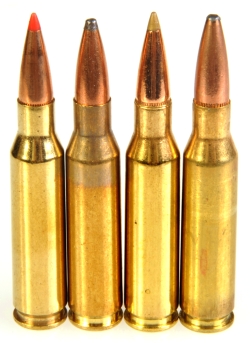
I spent quite a bit of time shooting the Model 770 to both assess accuracy, barrel temp rise and velocity. The Model 770’s barrel listed as button rifled, ordnance grade steel which is a departure from hammer forged barrels in process. The term “ordnance steel” is not a negative connotation. It’s just a broad characterization rather than an alloy specification for barrel steel.
| Ammunition |
Bullet |
Listed MV |
Listed ME |
Actual MV |
Actual ME |
| Privi Partizan PSP | 140 | 2854 | 2537 | 2731 | 2319 |
| Remington AccuTip | 140 | 2860 | 2542 | 2810 | 2455 |
| Remington Core-Lokt | 140 | 2860 | 2542 | 2834 | 2497 |
| Hornady Superformance | 139 | 2950 | 2686 | 2920 | 2632 |
Velocity performance was on par with other quality 22″ barrel firearms chambered for the 7mm-08 Remington. The listed velocity for the factory ammunition indicated is predicated on use of a 24″ barrel. At 2″ shorter, the Remington gave up little to specification.
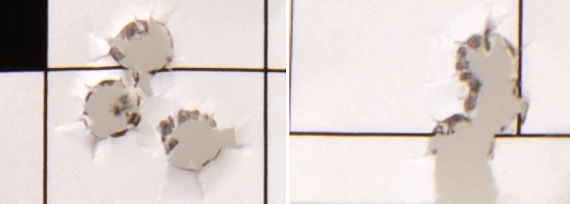
Two sub MOA groups shot from a cradle with Remington AccuTip 140 grain ammo, left and right; 5/8″ and 1/2″ respectively and these were not great exceptions. This Model 770 is a very accurate system by design and, I would guess, the lug seats being integral to the barrel and the floating three lug bolt head have a lot to do with this, a nice combination of controlled concentricity and parallel planes. Whatever the reasons, the gun works and it works well.
Some compromises create real value…
The economics of my life have varied more than my interests. Sounds very philosophical, Joe, what the heck does that mean? I’m just saying that I have enjoyed hunting and shooting most of my adult life, while family priorities and employment have had a significant impact on the types of equipment I could purchase. So over the years I’ve hunted with borrowed rifles and I’ve had my share of fancy shmansy firearms I was hesitant to rest on a shooting bench for fear of causing a minor blemish. These days I favor more moderately priced production rifles, or I build my own, so an inordinate amount of concern for the gun’s well being doesn’t put a damper on shooting activitities.

The Remington Model 770 is not a gun you would probably buy, then drop off at a master engraver to have something nice put on its receiver. But if you’re on a budget, want to hunt and you need something reliable and accurate to put food on the table or a trophy on the wall, the Model 770 could lead off a list of good choices in firearms. In lighter chambers, the Model 770 would be great for a young hunter; light recoil, good performance, solid reliability and without fear for damage to the stock or finish. With a 24″ barrel in 7mm Remington or 300 Winchester magnum, the 770 would be suitable for just about anything in North America. In 2006, when released, this model carried an MSRP of $452. Today, MSRP is $373 for the rifle and scope package. That’s a value that is tough to beat and worth a look.

Email Notification